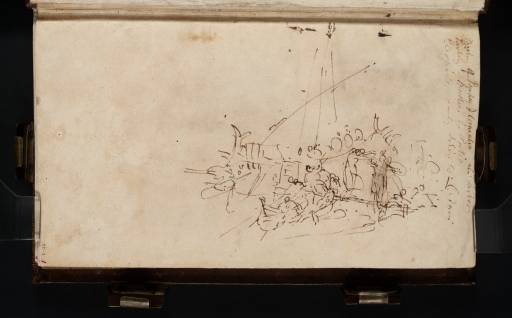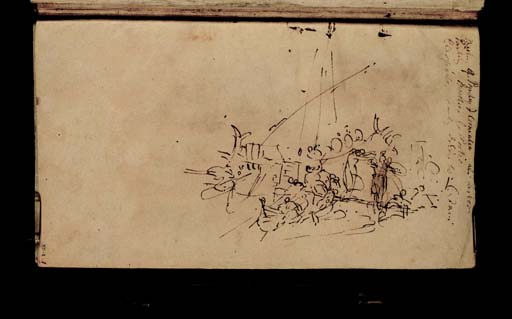Joseph Mallord William Turner A Ship and Figures 1805
Image 1 of 2
Joseph Mallord William Turner,
A Ship and Figures
1805
Joseph Mallord William Turner 1775–1851
Folio 1 Recto:
A Ship and Figures 1805
D05491
Turner Bequest XC 1
Turner Bequest XC 1
Pen and ink on off-white wove paper, 150 x 258 mm
Inscribed by Turner in ink ‘Meeting of Pompey & Cornealia at Lesbos | Parting of Brutus & Portia | Cleopatra sailing down to Cydnus’ inside right margin, descending vertically
Inscribed by John Ruskin in red ink ‘1’ bottom left, descending vertically
Stamped in black ‘XC 1’ bottom left, descending vertically
Inscribed by Turner in ink ‘Meeting of Pompey & Cornealia at Lesbos | Parting of Brutus & Portia | Cleopatra sailing down to Cydnus’ inside right margin, descending vertically
Inscribed by John Ruskin in red ink ‘1’ bottom left, descending vertically
Stamped in black ‘XC 1’ bottom left, descending vertically
Accepted by the nation as part of the Turner Bequest 1856
References
1909
A.J. Finberg, A Complete Inventory of the Drawings of the Turner Bequest, London 1909, vol.I, p.233, XC 1, as ‘Study for a picture of embarkation scene’.
1974
Gerald Wilkinson, The Sketches of Turner, R.A. 1802–20: Genius of the Romantic, London 1974, p.106.
1987
Andrew Wilton, Turner in his Time, London 1987, pp.69–70.
1990
Kathleen Nicholson, Turner’s Classical Landscapes: Myth and Meaning, Princeton 1990, pp.68, 223, 259 note 18, 309 reproduced pl.1.
1993
David Hill, Turner on the Thames: River Journeys in the Year 1805, New Haven and London 1993, pp.59 reproduced pl.70, 160 as ‘Study of a Roman embarkation scene’.
2005
Peter Ackroyd, J.M.W. Turner, Brief Lives, London 2005, p.36.
The ship is of ancient design. Nicholson describes it as ‘an ornate little ship with rowers ready for departure’. Two figures greet each other. Turner owned a copy of a 1657 edition of Thomas North’s translation of Plutarch’s Lives of the Noble Greeks and Romans Compared Together1 and also the 1786 edition of Oliver Goldsmith’s Roman History. In the front of the latter he jotted a list of subjects: ‘Cleopatra sailing down the Cydnus | Hannibal crossing the Alps | his departure from Carthage the | decline of that Empire – Regulus returns ... | Pompey. Arrival at ?Lesbos after the | Battle’.2 The Pompey and Cleopatra ideas are repeated here.
Pompey married Cornelia as his fifth wife in 52BC; she witnessed his murder from their ship when he stepped ashore in Egypt, having fled Rome after defeat by his rival Julius Caesar. Brutus married Portia (Porcia) in 45BC after divorcing his previous wife. Having also plotted against Caesar, he was forced into exile in Macedonia and committed suicide after defeat in the second battle of Philippi in 43BC. Turner’s third idea for this subject, Antony and Cleopatra, is elaborated on folio 84 verso of the sketchbook (D05671). In 41BC, Mark Antony summoned Cleopatra, who was suspected of giving assistance to Cassius, one of the assassins of Caesar, to his headquarters in Anatolia. She sailed from Egypt across the Mediterranean to Tarsus, up the River Cydnus. In no mood to apologise, she arrived in a golden barge dressed as Aphrodite and Mark Antony was immediately smitten. Despite this, Hill cites the sketch as evidence of Turner’s tendency to dwell on ‘fateful partings from widows’ (Cornelia, Portia and Cleopatra all having lost their husbands and lovers) and speculates on a possible connection with his relationship with Sarah Danby, the widow alleged to be his lover and the mother of his natural daughters.3 In this analysis, Turner’s personal emotional circumstances join his experience of the Thames landscape as subjects for imaginative transformation in the sketchbook.
To a greater or lesser extent, a number of studies in the book relate to a composition of an ancient seaport (sometimes Carthage), derived from the pictures of Claude Lorrain and shown with arriving or departing figures. See for example folios 1 verso–2 (D05492–D05493), a similar design on folio 11 verso (D05506), folios 33 verso, 34, 34 verso, 38 verso and 49 verso–50 (D05540, D05541, D05542, D05550, D05568–D05569).
David Blayney Brown
August 2007
Andrew Wilton and Rosalind Mallord Turner, Painting and Poetry: Turner’s ‘Verse Book’ and his Work of 1804–1812, exhibition catalogue, Tate Gallery, London 1990, p.80, where ‘Lesbos’ is given as ‘Lisbon’.
How to cite
David Blayney Brown, ‘A Ship and Figures 1805 by Joseph Mallord William Turner’, catalogue entry, August 2007, in David Blayney Brown (ed.), J.M.W. Turner: Sketchbooks, Drawings and Watercolours, Tate Research Publication, December 2012, https://www


